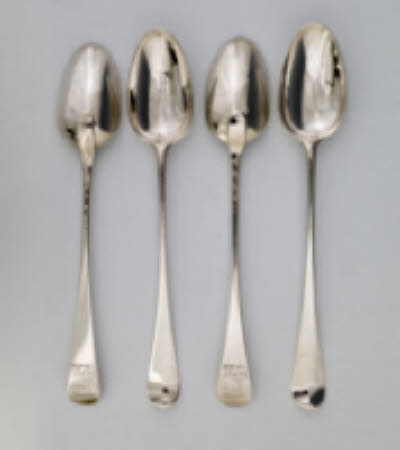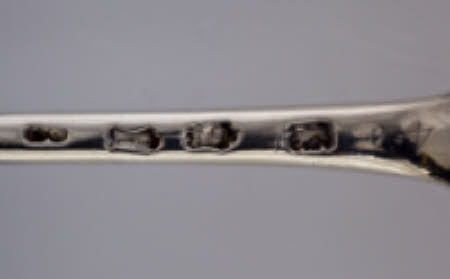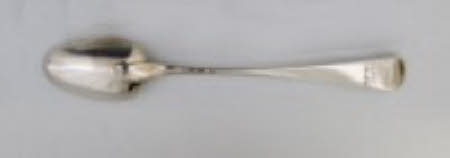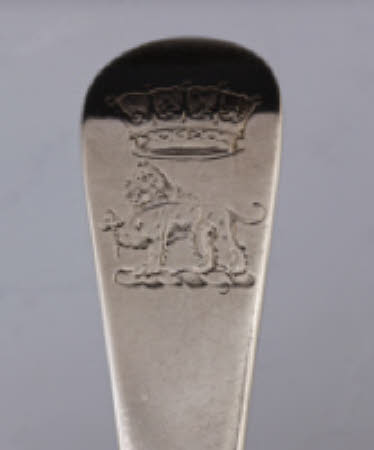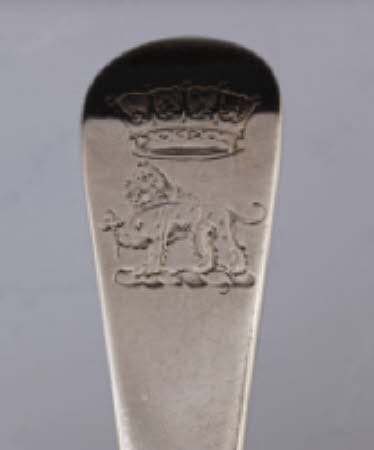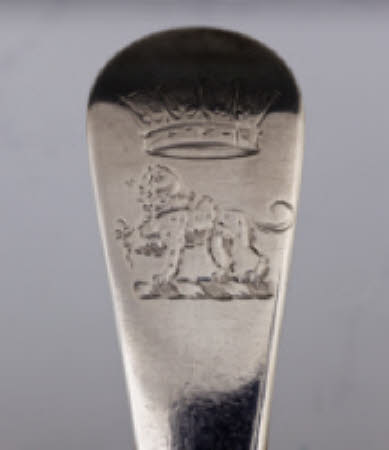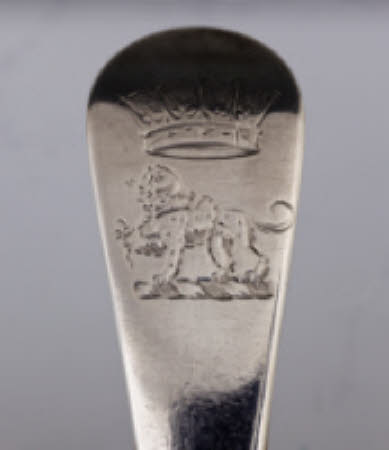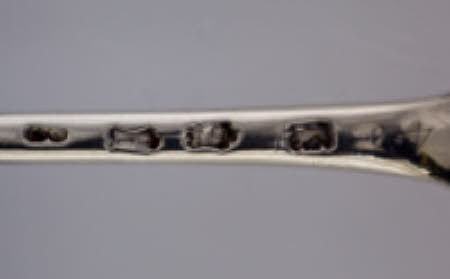Ragout spoon
Ebenezer Coker (d.1783)
Category
Silver
Date
1751 - 1755
Materials
Sterling silver
Measurements
497 g (weight); 28.6 cm (Length)
Place of origin
London
Order this imageCollection
Ickworth, Suffolk
NT 853248
Summary
Four ragout spoons, sterling silver, by Ebenezer Coker, London, 1751/2 (2) and 1754/5 (2). The spoons are forged from single pieces of silver and are of the Hanoverian single drop pattern with raised egg-shaped bowls, plain, tapering stems and single drops at the junction with the bowl. The terminals are upturned on the bowl side with slight ribs. Each terminal is engraved on the opposite side to the bowl with the Hervey crest beneath an earl's coronet. Hallmarks: Each is fully marked on the underside of the stem with maker’s mark ‘EC’ italics in a shaped punch (Arthur Grimwade, London Goldsmiths 1697-1837, 1990, no. 556), lion passant, leopard’s head crowned and date letters ‘q’ and ‘t’. Scratchweights: ‘4=1’, ‘4=2’, ‘4=0’ and ‘4=1’
Full description
These spoons are of the standard pattern for the mid eighteenth century, as was the rest of Lord Bristol’s flatware apart from the set for dessert acquired in 1758 (NT 852204 & 852098). Although they may have been supplied in two batches it is probably more likely that all four came in 1754-5 and that two were from stock. Ragouts were rich, sauced dishes of meat, game, fish or vegetables probably first developed in early seventeenth-century France and increasingly popular on both sides of the Channel over the first half of the eighteenth century.[1] As they were of a sloppy consistency and might be at some distance from the diner they required long-handled spoons to serve them. Such spoons, which would also have been used for fricassees (thickened using egg yolks and cream rather than a roux),[2] had been part of the necessary equipment for the dining table since the beginning of the century. The 1st Earl of Bristol’s accounts include a payment of £15 15s on 7 July 1700 to ‘Williams ye french silversmith [David Willaume I] for 2 pottage & 4 ragow spoons’ and it may have been these that the 2nd Earl exchanged in 1754 to get an updated set of four. An additional two, matching, were acquired whilst he was in Turin (private collection)[3] and the total was brought up to twelve in 1758 as part of Lord Bristol’s ambassadorial allocation of plate (NT 852099.45-50). Whilst abroad, and particularly in Madrid, he would have had regular need to dine in state, with three courses before dessert all of which would have included ragouts or fricassees, so the full dozen might well have been made use of at a single meal. There has been much debate about the respective work of Ebenezer Coker and Elias Cachart, their marks being very similar. These spoons clearly bear Coker’s mark and Ian Pickford has shown that though he has been assumed to have been a maker primarily of candlesticks and salvers he was actually also a significant spoon-maker, with several others prominent in the field having been his apprentices, including Thomas Chawner and John Lambe.[4] James Rothwell, Decorative Arts Curator January 2021 [Adapted from James Rothwell, Silver for Entertaining: The Ickworth Collection, London 2017, cat. 52, p. 136.] Notes: [1] Susan Pinkard, A Revolution in Taste: The Rise of French Cuisine 1650-1800, 2009, pp. 107-9 & 124. [2] Ibid., p. 140. [3] I am grateful to the owner for drawing them to my attention and allowing me to make an inspection. They bear the Turin mint mark of a Savoy cross surmounted by another couped cross in a shield beneath a crown enclosing a trefoil (see Augusto Bargoni, ‘Argenti’ in volume 3 of Vittoria Viale, (ed.), Mostra del Barocco Piemontese, 1963, p. 15, no. 79, ill.) and the counter assay mark of Bartolomeo Pagliani (in office 1753–75), BP in a dotted oval (see Gianfranco Fina and Luca Mana, Argenti Sabaudi del XVIII Secolo, 2012, p. 248, ill.). The terminals are engraved with the Hervey crest beneath an earl’s coronet, executed by an Italian hand. The scratchweights are ‘3-6/8’ and ‘3=4/8 - 1/2’. [4] Ian Pickford, Silver Flatware: English Irish and Scottish1660-1980, 1983, pp. 31-2.
Provenance
George Hervey, 2nd Earl of Bristol (1721–75); by descent to the 7th Marquess of Bristol (1954-99) and probably sold privately by him; Robert P. Eaton; Christie’s New York, 23 October 2013, lot 116; purchased by the National Trust via Christopher Hartop for $3,800 ($4,750 inclusive of premium), partly funded by gifts and bequests.
Credit line
Ickworth, the Bristol Collection (National Trust)
Makers and roles
Ebenezer Coker (d.1783), goldsmith
